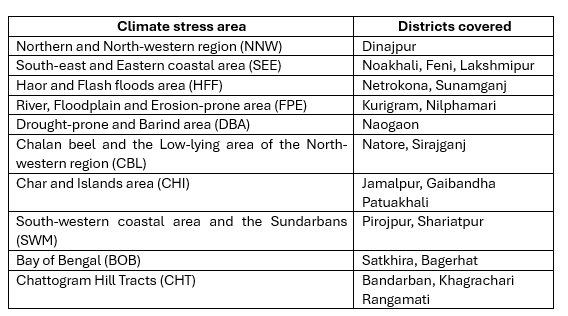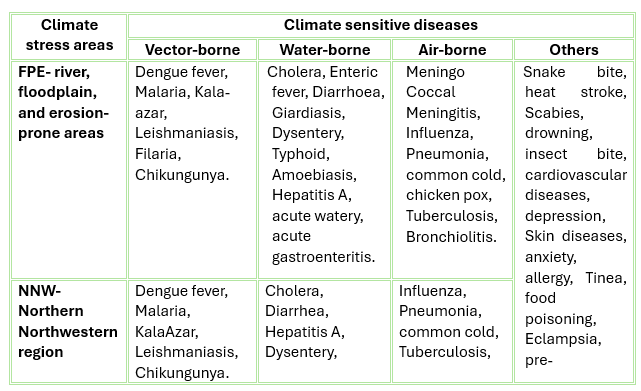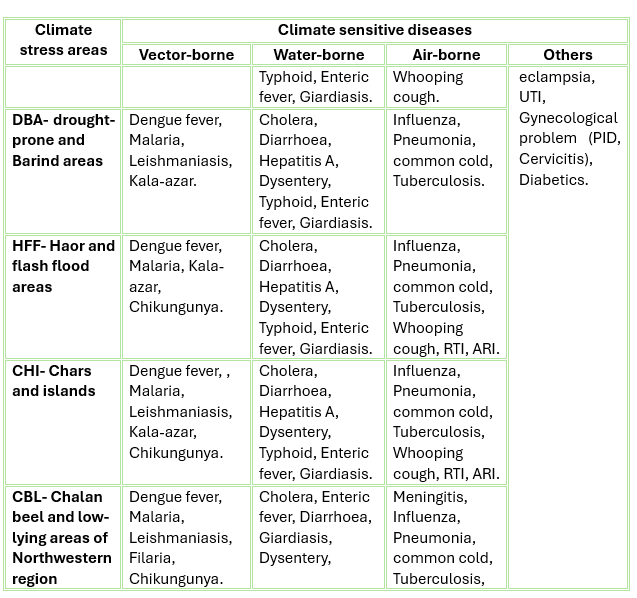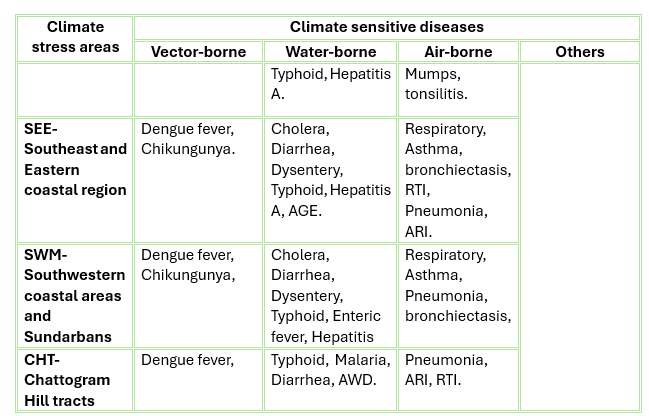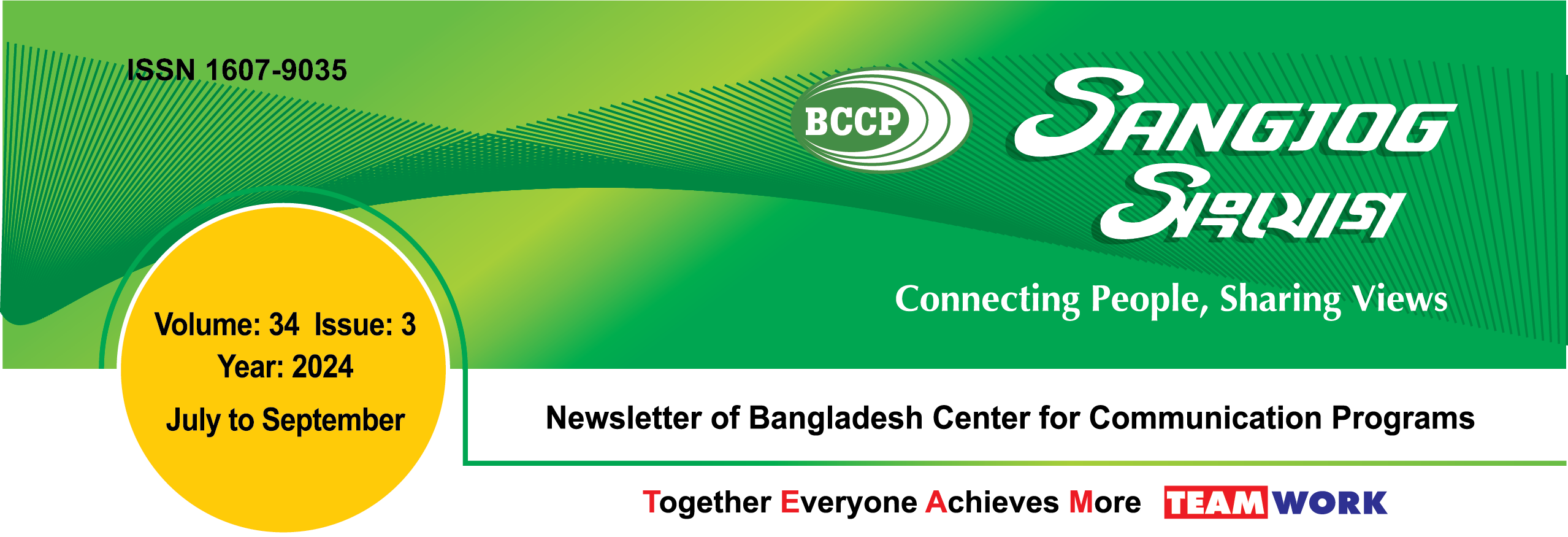

Youth unemployment: the dynamics and challenges related with Bangladesh's social development and economic growth

Climate change: A country-wide comprehensive training program carried on by BCCP to capacitate health professionals
A widescale and comprehensive training program has been carried out by BCCP in 21 climate stressed districts to capacitate health professionals of the GoB’s health care facilities at the upazila and districts. With the funding support from the World Health Organization this training program followed two aspects of the climate change issues as “Climate Change and Health” and “Climate Informed Hospital Emergency Preparedness and Response Plan”. Both these important issues of climate change have been addressed in two separate curriculums for the training program titled as “Climate Change and Health” and “Climate Informed Hospital Emergency Preparedness and Response Plan” which is followed by the global standard curriculum developed by WHO and has further been adopted by the IEDCR of the DGHS. Started from the May 27, 2024 this training has been ended up at September 12, 2024.
Objective of developing two curriculumsIn respect to developing two curriculums the objective was that the climate change has an impact on a wide range of health care program areas, including communicable and noncommunicable diseases, maternity and child health, nutrition and so on. Professionals in the public health and private health sectors are lack of up-to date knowledge on the harmful effect of climate change on human health and health system, as well as how to adopt the sectors to increasing climate impact on health in a systemic manner. The curriculum on “Climate Change and Health” was focused to build the capacity of the health sector professionals, includes health managers, medical doctors and nurses; by expanding technical knowledge on the impact of climate change on health and improve capacity to deal with the additional diseases burden caused by climate change in climate vulnerable areas of the country. The curriculum on “Climate informed Hospital Emergency Preparedness and Response Plan” was developed considering the tool suggested by the WHO on pandemic management.
 It was structured according to nine key components each with a list of priority actions. As hospitals are experiencing an excessive demand for health services due to critical events are strongly to be prepared to implement each action of hospital emergency preparedness and response plan effectively and as soon as required. This effort aims to provide technical guidelines and procedures to health managers and workers for managing health emergencies and strongly incorporated the climate parameters to become strong vibe as climate change is the next threat of the world as well as to Bangladesh and the community people.
Both training courses were for two days each where the training on “Climate Change and Health” was followed with the “Climate informed Hospital Emergency Preparedness and Response Plan”. The participants of these training programs were the health managers, medical officers, medical consultants and nurses of the Upazila Health Complexes (UHCs), district hospital and the supervisory doctors of the Civil Surgeon offices.
BCCP in consultation with IEDCR, DGHS and WHO prepared and finalized the training curriculum, training schedule, dates, venues, arranged necessary equipment, logistics and ensured presence of participants through call-up notice. Maintaining good liaison with Manager GEF project and IEDCR-DGHS, BCCP also arranged to send invitation through Civil Surgeons of respective districts to the participants for entire 25 batches of training program in 21 districts to provide training to 500 GoB Health Managers/Professionals of 11 climate stressed areas in Bangladesh.
Conduction of training
It was structured according to nine key components each with a list of priority actions. As hospitals are experiencing an excessive demand for health services due to critical events are strongly to be prepared to implement each action of hospital emergency preparedness and response plan effectively and as soon as required. This effort aims to provide technical guidelines and procedures to health managers and workers for managing health emergencies and strongly incorporated the climate parameters to become strong vibe as climate change is the next threat of the world as well as to Bangladesh and the community people.
Both training courses were for two days each where the training on “Climate Change and Health” was followed with the “Climate informed Hospital Emergency Preparedness and Response Plan”. The participants of these training programs were the health managers, medical officers, medical consultants and nurses of the Upazila Health Complexes (UHCs), district hospital and the supervisory doctors of the Civil Surgeon offices.
BCCP in consultation with IEDCR, DGHS and WHO prepared and finalized the training curriculum, training schedule, dates, venues, arranged necessary equipment, logistics and ensured presence of participants through call-up notice. Maintaining good liaison with Manager GEF project and IEDCR-DGHS, BCCP also arranged to send invitation through Civil Surgeons of respective districts to the participants for entire 25 batches of training program in 21 districts to provide training to 500 GoB Health Managers/Professionals of 11 climate stressed areas in Bangladesh.
Conduction of training As per the contract of the assignment BCCP was entrusted to conduct 25 batches of two-day long non-residential training on each of the two separate trainings for health professionals in climate stressed areas of Bangladesh.
 Accordingly, BCCP conducted all of 25 batches and provided training to 499 Health Managers/Professionals including UHFPO, Residential Medical Officer, Medical Officer, Nursing Supervisor and the Senior Staff Nurses. Among the participants, 295 were male and 204 were female. In terms of participants ratio by male and female, 59.12% were male and 40.88% were female. The number of district and climate stressed areas covered was 21 and 11, respectively. The number of Upazila covered was 155 and number of Health Care Facility covered was more than 155 where the Health Care Facilities were District Sadar Hospital and Upazila Health Complexes by category.
Accordingly, BCCP conducted all of 25 batches and provided training to 499 Health Managers/Professionals including UHFPO, Residential Medical Officer, Medical Officer, Nursing Supervisor and the Senior Staff Nurses. Among the participants, 295 were male and 204 were female. In terms of participants ratio by male and female, 59.12% were male and 40.88% were female. The number of district and climate stressed areas covered was 21 and 11, respectively. The number of Upazila covered was 155 and number of Health Care Facility covered was more than 155 where the Health Care Facilities were District Sadar Hospital and Upazila Health Complexes by category. Participants by category of health professionals were as below: Among these participants, Facility Manager (UHFPO) were 27.25%, Doctors (including Residential Medical Officers-RMO, Medical Officers, Medical Officers-Disease Control, Specialist Medical Consultants) were 40.48%, Nurses (including Nursing Supervisor, Senior Staff Nurse and Staff Nurse) were 31.46%, and others (including Health Inspectors, Medical Technicians, Health Education Officers) were 0.80%. To ease the execution of the training program within the stipulated time frame BCCP also arranged simultaneous batches of training in four districts. All these training programs were held at the district level and the Civil Surgeons of respective districts inaugurated the opening and closing sessions of all these training programs. A common urge was resonated amongst the entire training programs by the Civil Surgeons that underscored the need for training on “Climate Change and Health” and “Climate informed Hospital Emergency Preparedness and Response Plan” to know about the impact and effect of climate change and manage the health outcome efficiently. The training on “Climate Change and Health”
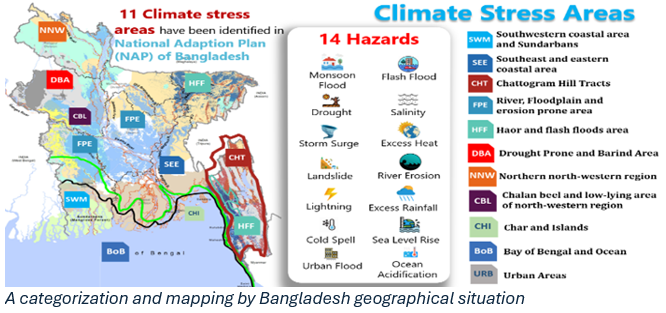 In the training on “Climate Change and Health”, participants were engaged to work out climate sensitive diseases of climate stressed areas they are working on at present. The exercise over these findings were regularly conducted and the information has been collected from eleven climate stressed areas in Bangladesh.
The Climate Stressed areas of Bangladesh have been earmarked in different zones based on the nature of the effect of climate change which are; Char and Islands area (CHI), Haor and Flash Floods area (HFF), River, Floodplain and Erosion‐prone area (FPE), Drought‐prone and Barind area (DBA), Northern and North‐western region (NNW), Chalan beel and the Low‐lying area of the North‐ western region (CBL), South-east and Eastern coastal area (SEE), South-western coastal area and the Sundarbans (SWM), Bay of Bengal (BOB), Chattogram Hill Tracts (CHT), and Urban areas (URB). These 11 climate stressed areas comprised of 21 districts have been taken on in BCCP’s training rollout plan. These 21 districts are Natore, Naogaon, Dinajpur, Nilphamari, Kurigram, Gaibandha, Natrokona, Jamalpur, Shariatpur, Patuakhali, Pirojpur, Feni, Noakhali, Laxmipur, Khagrachari, Rangamati, Satkhira, Bagerhat, Sirajganj, Sunamganj and Bandarban.
The training program was held in 21 districts that covered the climate stressed areas across Bangladesh were as below:
Findings over the collected information
In the training on “Climate Change and Health”, participants were engaged to work out climate sensitive diseases of climate stressed areas they are working on at present. The exercise over these findings were regularly conducted and the information has been collected from eleven climate stressed areas in Bangladesh.
The Climate Stressed areas of Bangladesh have been earmarked in different zones based on the nature of the effect of climate change which are; Char and Islands area (CHI), Haor and Flash Floods area (HFF), River, Floodplain and Erosion‐prone area (FPE), Drought‐prone and Barind area (DBA), Northern and North‐western region (NNW), Chalan beel and the Low‐lying area of the North‐ western region (CBL), South-east and Eastern coastal area (SEE), South-western coastal area and the Sundarbans (SWM), Bay of Bengal (BOB), Chattogram Hill Tracts (CHT), and Urban areas (URB). These 11 climate stressed areas comprised of 21 districts have been taken on in BCCP’s training rollout plan. These 21 districts are Natore, Naogaon, Dinajpur, Nilphamari, Kurigram, Gaibandha, Natrokona, Jamalpur, Shariatpur, Patuakhali, Pirojpur, Feni, Noakhali, Laxmipur, Khagrachari, Rangamati, Satkhira, Bagerhat, Sirajganj, Sunamganj and Bandarban.
The training program was held in 21 districts that covered the climate stressed areas across Bangladesh were as below:
Findings over the collected information From the training session in different climate stressed areas of Bangladesh, the BCCP team found some contributing factors associated with diseases. The below table shows that the most common diseases are derived from waterborne and vector-borne diseases. Some airborne diseases also emerge due to climate change. Adding to that malnutrition, mental health problems and cardiovascular diseases are also found in different areas.
The findings over the climate sensitive diseases by climate stress areas
Training on “Climate informed Hospital Emergency Preparedness and Response Plan”
The training on “Climate informed Hospital Emergency Preparedness and Response Plan” in Climate Stressed Areas was based on the training manual that was developed for the health managers, professional and allied staff of the primary, secondary and tertiary level hospitals. The topic of the manual covers nine components, those are considered to essentially focus on during an emergency for hospital preparedness and response plan, includes Command and Control, Communication, Safety and Security, Triage, Surge Capacity, Continuity of Essential Services, Human Resources, Logistics and Supply Management and Post Disaster Recovery. Some of these components were followed by a few practice sessions to conduct during the training while the manual had all these sessions that have been associated with exercise tools. The Climate informed Hospital Emergency Preparedness and Response Plan was prepared considering the tool suggested by the WHO on pandemic management. It was structured according to, as mentioned above, nine key components each with a list of priority actions. As hospitals are experiencing an excessive demand for health services due to critical events are strongly to be prepared to implement each action of hospital emergency preparedness and response plan effectively and as soon as required. Following a health care facility wise group work, a facility level action plan on Climate Informed Hospital Emergency Preparedness which was developed by the entire 155 health care facilities comprised of Upazila Health Complex and the District Hospitals.
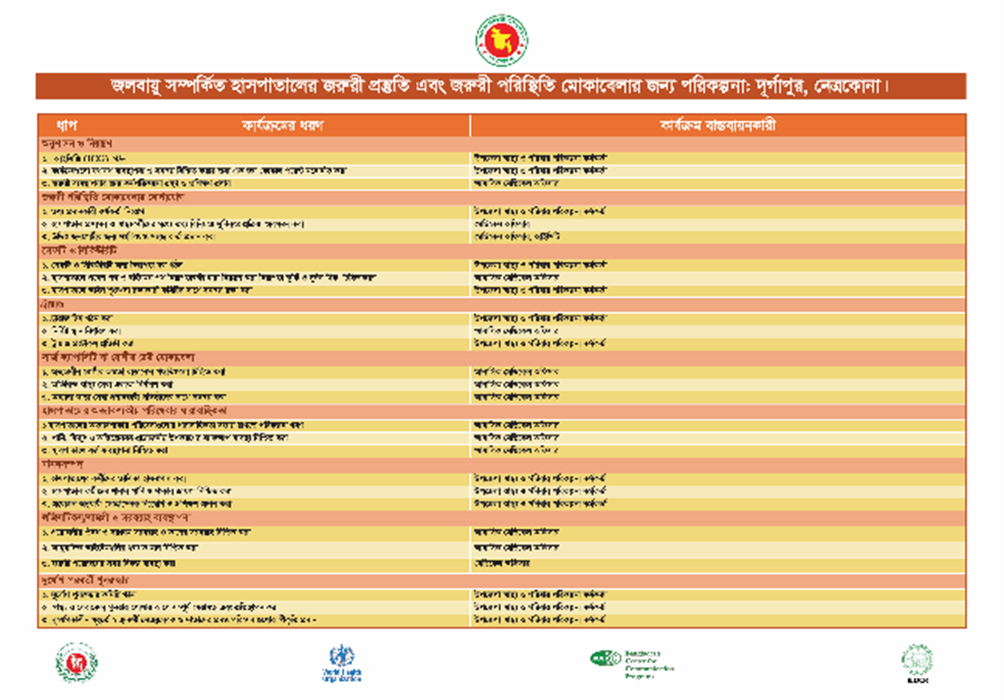 These actions plans were presented in the plenary and have been locally produced through printing, laminating and framing. Necessary arrangements were undertaken to have these plans procured by the respective Civil Surgeon offices from the vendors. In the training program the UHFPOs’ and the participants of the District Hospitals were requested to get it collected from the Civil Surgeon office after it is produced and make it displayed in certain places of the office. BCCP is regularly monitoring the production, procurement and display of the printed version of the action plan.
Training methodology
These actions plans were presented in the plenary and have been locally produced through printing, laminating and framing. Necessary arrangements were undertaken to have these plans procured by the respective Civil Surgeon offices from the vendors. In the training program the UHFPOs’ and the participants of the District Hospitals were requested to get it collected from the Civil Surgeon office after it is produced and make it displayed in certain places of the office. BCCP is regularly monitoring the production, procurement and display of the printed version of the action plan.
Training methodology BCCP has made a special effort to engage participants of the training program in the course activities following Review, Discussion and Synthesis (RDS) process, and to satisfy the requirements in an effective and efficient manner. However, BCCP were flexible and keen to learn from WHO, value their opinion and come to consensus through discussion because BCCP believes that there is no absolute approach to addressing different issues. Attaining smooth completion of the project activities and the submission of the progress/accomplishment report with quality was always their high priority. Conclusion
In the backdrop of Bangladesh’s current climate change related extreme weather which has been pounding the people’s health and health systems in different ways, especially in the climate stressed areas, brings hospitals as the first points of contact for the stressed people. WHO funding and IEDCR’s technical and administrative support in implementation of capacity building of the health managers, doctor and nurses to receive the training on Climate Change and Health and Climate informed Hospital Emergency Preparedness and Response Plan will profusely contributing towards hospital level preparedness during emergencies and thus will work as mitigating the health hazards caused by the climate change.
Women tenderers demand training on e-GP
Women entrepreneurs and tenderers at a workshop on 19 September 2024 demanded more training for them on electronic Government Procurement (e-GP) system introduced by Bangladesh Public Procurement Authority (BPPA).
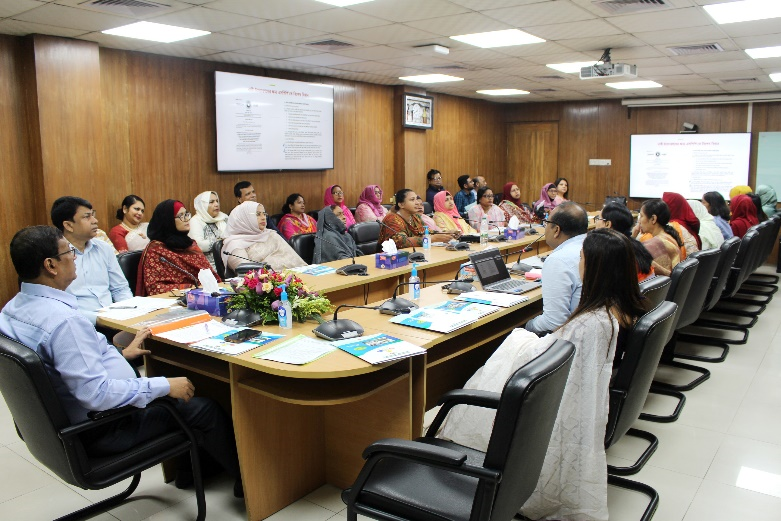 BPPA has been providing one-day training to tenders on e-GP. The women tenderers demanded that the duration of the training should be longer. BPPA has responded positively to their demand.
BPPA conducted the workshop in its conference room at BPPA Bhaban on the campus of the Bangladesh Planning Commission in Dhaka. The workshop was aimed at encouraging women's participation in public procurement processes.
The workshop was part of communication program of BPPA for discussions on BPPA's functions and progress of e-GP.
About 40 women entrepreneurs, who are already registered in the e-GP system, participated in the workshop. This workshop is expected to play a significant role in creating new opportunities for women through e-GP and the public procurement process. The workshop was conducted under the DIMAPP project, which is being implemented by BPPA. Bangladesh Center for Communication Programs (BCCP) managed the workshop.
At the beginning of the workshop, a welcome speech was delivered by Director of BPPA Ms Laboni Chakma. This was followed by a detailed presentation made by Director of BPPA Mr. Md. Sakhawat Hossain on BPPA functions, sustainable public procurement, e-GP progress and women’s participation in public procurement.
Mr. Abul Kashem Md. Mohiuddin, Secretary of the Implementation, Monitoring, and Evaluation Division (IMED) under the Ministry of Planning, was present as the Chief Guest in the workshop. Chairperson of the workshop and BPPA's Chief Executive Officer (CEO), Mr. Mirza Ashfaqur Rahman, gave the closing remarks. BPPA officials were also present at the event.
After the presentation, participants took part in an open discussion where they shared their experiences, challenges, and potentials of e-GP and public procurement. They also gave suggestions regarding the easiness of women’s participation in public procurement. The Secretary, IMED, responded by saying that these would be taken into consideration while making amendments to procurement act, rules, and e-GP Guidelines.
The CEO of BPPA said that women across the world constitute only 40 per cent of global entrepreneurs. In Thailand, it is 26per cent of its total entrepreneurs, in India it is 22 per cent and in Bangladesh it is only 7.3 per cent. In e-GP system of BPPA, the number of registered women tenderers is 4,205. The total number of tenderers now registered in e-GP system is 1,16,119.
Previously, BPPA also organized similar workshops aimed at increasing women's participation in public procurement, during which the IMED Secretary advised highlighting success stories of women tenderers. In continuation, BPPA has gathered several success stories.
The active participation of women on the e-GP platform aligns with the country's economic progress, and this workshop was part of that effort. BPPA introduced e-GP in 2011, which has been widely accepted by both procuring entities and tenderers for its simplicity, speed, and reliability.
BPPA has been providing one-day training to tenders on e-GP. The women tenderers demanded that the duration of the training should be longer. BPPA has responded positively to their demand.
BPPA conducted the workshop in its conference room at BPPA Bhaban on the campus of the Bangladesh Planning Commission in Dhaka. The workshop was aimed at encouraging women's participation in public procurement processes.
The workshop was part of communication program of BPPA for discussions on BPPA's functions and progress of e-GP.
About 40 women entrepreneurs, who are already registered in the e-GP system, participated in the workshop. This workshop is expected to play a significant role in creating new opportunities for women through e-GP and the public procurement process. The workshop was conducted under the DIMAPP project, which is being implemented by BPPA. Bangladesh Center for Communication Programs (BCCP) managed the workshop.
At the beginning of the workshop, a welcome speech was delivered by Director of BPPA Ms Laboni Chakma. This was followed by a detailed presentation made by Director of BPPA Mr. Md. Sakhawat Hossain on BPPA functions, sustainable public procurement, e-GP progress and women’s participation in public procurement.
Mr. Abul Kashem Md. Mohiuddin, Secretary of the Implementation, Monitoring, and Evaluation Division (IMED) under the Ministry of Planning, was present as the Chief Guest in the workshop. Chairperson of the workshop and BPPA's Chief Executive Officer (CEO), Mr. Mirza Ashfaqur Rahman, gave the closing remarks. BPPA officials were also present at the event.
After the presentation, participants took part in an open discussion where they shared their experiences, challenges, and potentials of e-GP and public procurement. They also gave suggestions regarding the easiness of women’s participation in public procurement. The Secretary, IMED, responded by saying that these would be taken into consideration while making amendments to procurement act, rules, and e-GP Guidelines.
The CEO of BPPA said that women across the world constitute only 40 per cent of global entrepreneurs. In Thailand, it is 26per cent of its total entrepreneurs, in India it is 22 per cent and in Bangladesh it is only 7.3 per cent. In e-GP system of BPPA, the number of registered women tenderers is 4,205. The total number of tenderers now registered in e-GP system is 1,16,119.
Previously, BPPA also organized similar workshops aimed at increasing women's participation in public procurement, during which the IMED Secretary advised highlighting success stories of women tenderers. In continuation, BPPA has gathered several success stories.
The active participation of women on the e-GP platform aligns with the country's economic progress, and this workshop was part of that effort. BPPA introduced e-GP in 2011, which has been widely accepted by both procuring entities and tenderers for its simplicity, speed, and reliability.
ICT Corner
The Rise of ChatGPT: made a history in AI innovation
 In the ever-evolving landscape of information and communication technology (ICT), one innovation stands out for its remarkable ability to engage, inform, and assist users is the ChatGPT. Developed by OpenAI, this advanced language model is redefining how we interact with machines and access information, making it a topic of significant interest for our readers at Sangjog.
In the ever-evolving landscape of information and communication technology (ICT), one innovation stands out for its remarkable ability to engage, inform, and assist users is the ChatGPT. Developed by OpenAI, this advanced language model is redefining how we interact with machines and access information, making it a topic of significant interest for our readers at Sangjog.
Virtual Reality (VR) Technology is Changing Our Lives
Virtual Reality (VR) is a cool technology that lets you experience a world created by a computer. Instead of using a normal screen, you wear a special headset that shows you a 3D world, making it feel like you’re really there.
How Does VR Work? When you wear the VR headset, it tracks how you move. This lets you look around and even interact with things in the virtual world. You can explore space, visit historical places, or do other activities without leaving your home.
How We Use VR
When you wear the VR headset, it tracks how you move. This lets you look around and even interact with things in the virtual world. You can explore space, visit historical places, or do other activities without leaving your home.
How We Use VR 1. Learning and Training: VR is helping in education. For example, medical students can practice surgeries, and engineers can design buildings in a virtual world. Pilots can also train using VR. This way, people can learn new skills in a safe and real-feeling way.
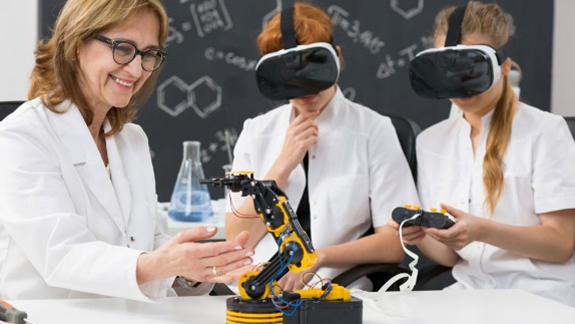 2. Healthcare: VR is helping people with mental health problems like anxiety and PTSD. It allows them to face their fears in a safe virtual space, which helps them feel better without real danger.
2. Healthcare: VR is helping people with mental health problems like anxiety and PTSD. It allows them to face their fears in a safe virtual space, which helps them feel better without real danger.
3. Fun and Games: VR is very popular in gaming. Players can visit new worlds, fight enemies, or solve puzzles in a 3D environment. It feels like you’re really “inside” the game, which is more exciting than regular video games.
 4. Real Estate and Travel: Want to check out a house or visit a new city without leaving your home? VR makes that possible. You can take virtual tours of homes or "travel" to places through VR.
4. Real Estate and Travel: Want to check out a house or visit a new city without leaving your home? VR makes that possible. You can take virtual tours of homes or "travel" to places through VR. 5. Virtual Shopping: VR lets people shop in a virtual store. You can explore products in 3D, interact with them, and even buy them. Companies like Walmart and Alibaba are already using VR for shopping. Why is VR Important?
VR can change how we learn, train, shop, and have fun. It gives us experiences that were hard to have because of distance or money.
As VR keeps improving, it will bring even more exciting things in many areas of life!
Editorial: Addressing the Youth Unemployment and Empowering Youth Leadership
Youth unemployment becomes as one of Bangladesh's most important development challenges. With a significant portion of the population under the age of 30, the country stands at a crucial crossroads: harness the potential of its young population for economic prosperity, or risk facing social unrest and an economic slowdown. Promoting youth leadership, combined with strategic communication, can be pivotal in addressing the unemployment challenges.
In a rapidly evolving job market, young people possess the creativity, adaptability, and energy necessary to drive innovation and generate employment opportunities. However, unlocking their potential requires concerted efforts from the government, business enterprises, industrial sector, NGOs and the civil society organizations. These efforts should aim to equip young people with relevant skills, networks, and opportunities for meaningful economic engagement. The Role of Government and NGOs in Empowering Youth:The Bangladesh government, in collaboration with private sector, NGOs and community-based organizations (CBOs), can take proactive steps to foster employment opportunities for the youth. An example can be drawn from the "Youth Skills and Employment Action Plan" recently announced by the government, which emphasizes technical education and vocational training (The Daily Star, 20 August 2024). Such initiatives highlight the importance of practical skills development, entrepreneurship support, and investments in growing sectors like technology and renewable energy. Government-backed programs in collaboration with businesses, alongside community-driven initiatives led by NGOs, can provide young entrepreneurs with the necessary mentorship, financial support, and technical training to thrive. Moreover, it is imperative to bridge the gap between academic education and the practical demands of the job market. This can be achieved through industry-specific training and internships programs that prepare young people for the rapidly evolving workforce. Addressing the mental health challenges for the youths is equally important which imposes the long-term unemployment. The psychological cost of joblessness is significant, and government and NGO initiatives should include mental health support services to alleviate these effects, as noted in Prothom Alo’s article on youth mental health amid rising unemployment (Prothom Alo, 17 August 2024). The Role of BCCP as a Communication Organization: As a leading communication organization, Bangladesh Center for Communication Programs (BCCP) has an important role to play in addressing youth unemployment through targeted communication and awareness initiatives. Through its ongoing projects—such as the "Student Leadership Development Workshops" and "Communication and Awareness for Emergency Multi-Sector Rohingya Crisis Response Project"—BCCP fosters leadership, voluntarism, and confidence in youth, while connecting them to self-employment opportunities and resources. The way Forward:
To address youth unemployment effectively, a multi-faceted approach is necessary:
- Invest in skill development: Educational curricula should be aligned with market demands, focusing on digital literacy, technical skills, and practical training. Initiatives like the "National Skills Development Authority" (NSDA) programs have demonstrated the value of public-private partnerships in preparing youth to get converted as workforce.
- Promote entrepreneurship: Young entrepreneurs should be given access to financing, training, and mentoring. The government's Startup Bangladesh initiative has offered funding to promising youth-led ventures, facilitating their growth.
- Build partnerships: Collaboration between businesses, educational institutions, and the government can lead to job programs that address both local and national employment challenges.
- Expand job opportunities in emerging sectors: The government’s push for renewable energy and technology sectors presents immense potential for youth employment.
- Provide mental health support: Addressing the emotional and psychological effects of unemployment is very important. Community-based mental health programs should be integrated into employment initiatives to ensure holistic support for job seekers.


What if polluters footed the climate bill?
In August 2022, Pakistan was devastated by catastrophic flooding. The unprecedented monsoon rains killed more than 1,500 people and left the inundated country with economic damages exceeding $30bn (£27bn). read more...

Social media platforms are using what you create for artificial intelligence. Here’s how to opt out
OpenAI has claimed that creating ChatGPT would have been impossible without using copyrighted works. LinkedIn is using user resumes to polish up its artificial intelligence model. read more...

From wastelands to wetlands: The fight to save Sri Lanka's natural flood buffers
Pay Drechsel is going for his daily morning walk around Thalangama Wetland, in Sri Lanka's capital Colombo. The Sun casts a warm glow over flowering pink water lilies as a farmer scrubs down his water buffalo read more...

Scientists store entire human genome on ‘memory crystal’ that could survive billions of years
Scientists in the United Kingdom have stored the entire human genome on a “5D memory crystal,” in the hope that it could be used in the future as a blueprint to bring humanity back from extinction read more...

WHO and partners establish an access and allocation mechanism for mpox vaccines, treatments, tests
In coordination with Member States, the World Health Organization (WHO) and partners have established an access and allocation mechanism for mpox medical countermeasures including vaccines read more...

What to Know About Mpox in 2024
For the second time in two years, the World Health Organization (WHO) has declared mpox a public health emergency of international concern. Mpox didn’t disappear in between the two outbreaks read more...

Enough is enough’: Rohingya demand end to violence in Myanmar
Tens of thousands of Rohingya refugees in Bangladesh have held rallies in camps to mark the seventh anniversary of the military crackdown in Myanmar that forced them to flee. read more...

Do You Really Need a Water Filter?
All sorts of nasties—lead, mercury, radium, nitrates, norovirus, agricultural runoff, PFAS, and more—can lurk in your water. No surprise, then, that about 40% of U.S. homes filter theirs. read more...
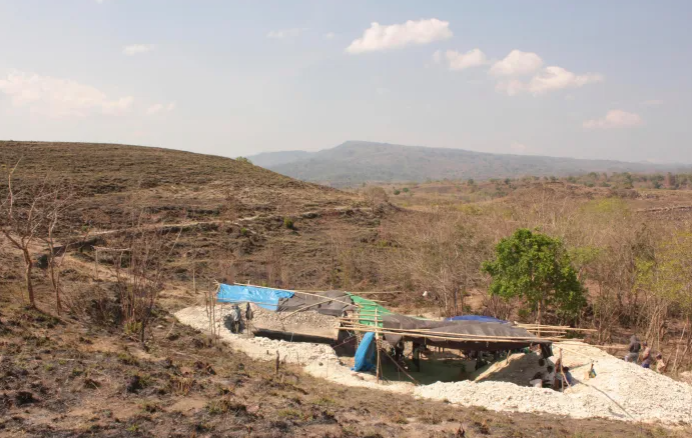
New study reveals more on early ‘Hobbit’ humans in Indonesia’s Flores
Now a new study suggests that the ancestors of the diminutive Homo floresiensis, nicknamed “Hobbits” after the fictional characters in The Lord of the Rings, were even shorter. read more...
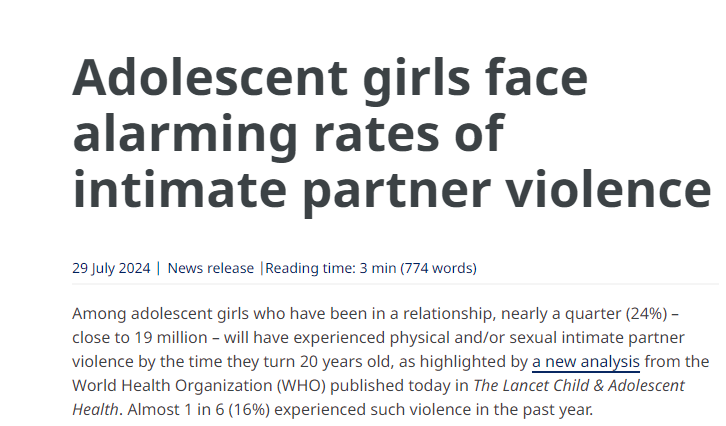
Adolescent girls face alarming rates of intimate partner violence
Among adolescent girls who have been in a relationship, nearly a quarter (24%) – close to 19 million – will have experienced physical and/or sexual intimate partner violence by the time they read more...

Where are the world’s millionaires and how is wealth divided globally?”
The world has at least 58 million US dollar millionaires, accounting for 1.5 percent of the global adult population, according to the 2024 UBS Global Wealth Report (PDF) read more...

How hot is your city compared with the rest of the world?
July 21 was the hottest day ever recorded globally, with an average temperature of 17.09C (62.76F), according to preliminary data from the European Union’s Copernicus Climate Change Service. read more...

China’s emissions of two potent greenhouse gases rise 78% in decade
Emissions of two of the most potent greenhouse gases have substantially increased in China over the last decade, a study has found. read more...

A fresh roadside pit revealed a dramatic shift in the Ganges. Scientists say they’ve traced the cause
Earthquakes, caused by the shifting of Earth’s tectonic plates, have the potential to transform the face of the world. Now, for the first time, scientists have evidence that earthquakes can reroute rivers read more...
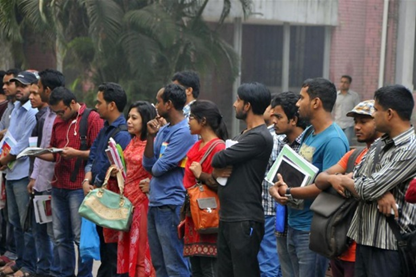 Economists and labor market experts attribute the high rate of inactive youth to various factors, including early marriage of girls, lack of necessary job skills, inadequate education, insufficient employment opportunities, and poor social conditions. Mental health is an important aspect of youth development. However, many young people face various mental health challenges such as anxiety, depression, and substance abuse. These challenges can arise from various factors such as social isolation, trauma, and family dysfunction.
Young population is an important human resource for development; they are vital elements for social, economic development and technological innovation change. But these resources have been facing a major challenge particularly the employment for young labor force. Young people have been disproportionately affected by unemployment, underemployment, vulnerable employment (sum of percentage of unpaid family workers and own account workers in the total employment) and working poverty. Even during periods of robust economic growth, the labor market is often unable to assimilate large numbers of youth.
Is Bangladesh in close to missing the demographic dividend
Economists and labor market experts attribute the high rate of inactive youth to various factors, including early marriage of girls, lack of necessary job skills, inadequate education, insufficient employment opportunities, and poor social conditions. Mental health is an important aspect of youth development. However, many young people face various mental health challenges such as anxiety, depression, and substance abuse. These challenges can arise from various factors such as social isolation, trauma, and family dysfunction.
Young population is an important human resource for development; they are vital elements for social, economic development and technological innovation change. But these resources have been facing a major challenge particularly the employment for young labor force. Young people have been disproportionately affected by unemployment, underemployment, vulnerable employment (sum of percentage of unpaid family workers and own account workers in the total employment) and working poverty. Even during periods of robust economic growth, the labor market is often unable to assimilate large numbers of youth.
Is Bangladesh in close to missing the demographic dividend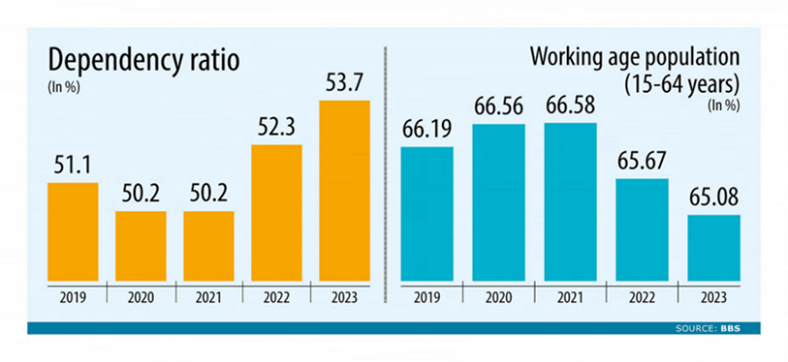 The following chart shows that state of the working age population in comparison to the dependent populations last five years (2019 – 2023). In both areas there are negative scenarios that means the dependency ratio is increasing on the contrary the working age population is decreasing.
Demographic dividend may turn into a liability
The following chart shows that state of the working age population in comparison to the dependent populations last five years (2019 – 2023). In both areas there are negative scenarios that means the dependency ratio is increasing on the contrary the working age population is decreasing.
Demographic dividend may turn into a liability 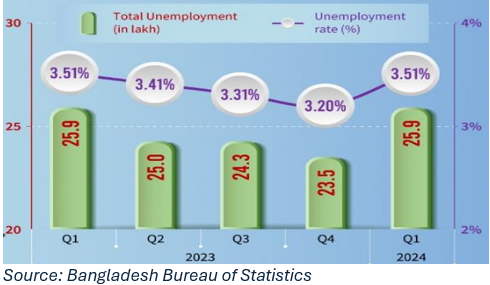 According to BBS Quarterly Labor Force Survey 2024, the jobless rate has increased to 3.51%. There were 23.5 lakh jobless persons in the nation in the fourth quarter of last year. On the other hand, it also showed that the unemployed ratio over the quarter 1 of year 2023 and 2024 found similar but in between the period from quarter 2 to quarter 4 of year 2023 it was in decreasing trend (decreased 3.51% to 3.20%) slightly (0.31% decreased).
The below graph also shows that, the number of unemployed among male and female group remain static by year-of-year (YoY) from Q1, 2023 to Q1, 2024. However, it was discovered during the year assessment that the rate of unemployed males fell by 0.24% and the rate of unemployed women fell by 0.45% from the start of the quarter to the conclusion of the quarter in 2023. The first quarter of 2024 saw a 0.31% increase in the unemployment trend, which was higher than the previous quarter of 2023 (Q4).
According to BBS Quarterly Labor Force Survey 2024, the jobless rate has increased to 3.51%. There were 23.5 lakh jobless persons in the nation in the fourth quarter of last year. On the other hand, it also showed that the unemployed ratio over the quarter 1 of year 2023 and 2024 found similar but in between the period from quarter 2 to quarter 4 of year 2023 it was in decreasing trend (decreased 3.51% to 3.20%) slightly (0.31% decreased).
The below graph also shows that, the number of unemployed among male and female group remain static by year-of-year (YoY) from Q1, 2023 to Q1, 2024. However, it was discovered during the year assessment that the rate of unemployed males fell by 0.24% and the rate of unemployed women fell by 0.45% from the start of the quarter to the conclusion of the quarter in 2023. The first quarter of 2024 saw a 0.31% increase in the unemployment trend, which was higher than the previous quarter of 2023 (Q4). 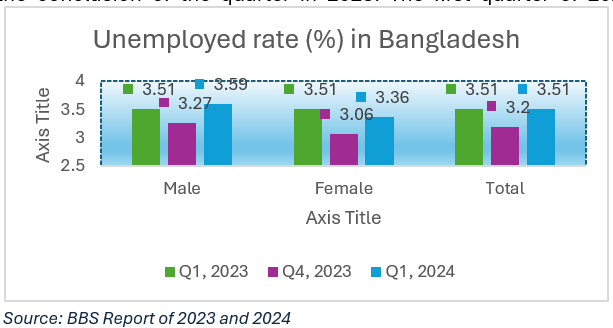 The impacts of unemployed invariably alike on graduates- mental depression, embarrassment, socioeconomic vulnerability, erosion of inner potentiality, frustration and degradation of personality. Unemployment is caused by various reasons that comes from both the demand side and supply side. Demand side reduction may be caused by high interest rates, global recession and financial crisis. From the supply side frictional unemployment and structural employment play a vital role for go. It doesn’t take research to see what an acute turn in unemployment has taken place in Bangladesh. It can easily be predicted from looking at the crowd of youth in front of the manpower recruitment agencies, seeking to go overseas. If there were job opportunities in the country, the youth would not have become so desperate to go abroad.
One-third of all the new employment opportunities that are created for Bangladeshi people every year are abroad.
The impacts of unemployed invariably alike on graduates- mental depression, embarrassment, socioeconomic vulnerability, erosion of inner potentiality, frustration and degradation of personality. Unemployment is caused by various reasons that comes from both the demand side and supply side. Demand side reduction may be caused by high interest rates, global recession and financial crisis. From the supply side frictional unemployment and structural employment play a vital role for go. It doesn’t take research to see what an acute turn in unemployment has taken place in Bangladesh. It can easily be predicted from looking at the crowd of youth in front of the manpower recruitment agencies, seeking to go overseas. If there were job opportunities in the country, the youth would not have become so desperate to go abroad.
One-third of all the new employment opportunities that are created for Bangladeshi people every year are abroad. 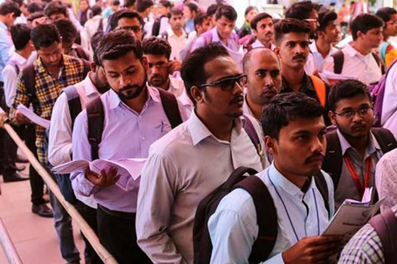 Malaysia, Singapore or the Middle Eastern countries are the primary destinations for the less educated youths. The number of Bangladeshi citizens who have moved to Europe sailing through the Mediterranean Sea between 2009 and 2024 is 106,598.
The degree of unemployment in the country can be estimated just from this figure.
The impact of youth unemployment in Bangladesh
Malaysia, Singapore or the Middle Eastern countries are the primary destinations for the less educated youths. The number of Bangladeshi citizens who have moved to Europe sailing through the Mediterranean Sea between 2009 and 2024 is 106,598.
The degree of unemployment in the country can be estimated just from this figure.
The impact of youth unemployment in Bangladesh 
